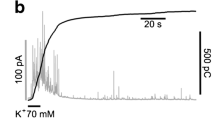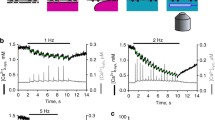Abstract
AN increase in the free ionised cytosolic Ca2+ concentration is generally regarded as the critical event necessary for the induction of exocytotic release of neurotransmitters and hormones from excitable cells. Stimulation of such cells is thought to result in an alteration of the membrane permeability to Ca2+ with a subsequent flow of Ca2+ ions down their gradient into the cytosol from the extracellular space1. In addition, release of Ca2+ from intracellular compartments–notably the mitochondria—mediated by a rise in intracellular cyclic AMP may also, in some systems, result in an increase in the cytosolic Ca2+ concentration and thus to exocytotic release2. Recent evidence suggests that small increases in Na+ concentration may release Ca2+ from mitochondria isolated from cardiac muscle cells3. Conversely, the uptake of Ca2+ into mitochondria of squid axoplasm is reduced by elevated sodium4. Since increases in the internal Na+ concentration occur during stimulation of many excitable cells, it is feasible that Na+ could act as a physiological releaser of Ca2+ from intracellular stores. We have obtained evidence for this possibility from studies designed to examine the role of Na+ in the calcium-dependent exocytotic release of insulin from the pancreatic β cell.
Similar content being viewed by others
References
Katz, B., The Release of Neural Transmitter Substances (Thomas, Sprngfield, Illinois, 1969).
Rasmussen, H., Science, 170, 404–412 (1970).
Carafoli, E., Tiozzo, R., Lugli, G., Crovelti, F., and Kratzing, C., J. molec. Cell Cardiol., 6, 361–371 (1974).
Baker, P. F., and Schlaepfer, W., J. Physiol., Lond., 249, 37P–38P (1975).
Lacy, P. E., Walker, M. M., and Fink, C. J., Diabetes, 21, 987–998 (1972).
Ohta, M., Narahashi, T., and Keller, R. F., J. Pharmac. exp. Ther., 184, 143–154 (1973).
Blaustein, M. P., J. Physiol., Lond., 247, 617–655 (1975).
Thoa, N. B., Wooten, G. F., Axelrod, J., and Kopin, I. J., Molec. Pharmac., 11, 10–18 (1975).
Baker, P. F., Progr. Biophys. molec. Biol., 24, 177–223 (1972).
Malaisse, W. J., Diabetologia, 9, 167–173 (1973).
Archibald, J. T., and White, T. D., Nature, 252, 595–596 (1974).
Baker, P. F., and Crawford, A. C., J. Physiol., Lond., 247, 209–226 (1975).
Lacy, P. E., and Kostianovsky, M., Diabetes, 16, 35–39 (1967).
Wright, P. H., Makulu, D. R., Vickick, D., and Sussmann, K. E., Diabetes, 20, 33–45 (1971).
Author information
Authors and Affiliations
Rights and permissions
About this article
Cite this article
LOWE, D., RICHARDSON, B., TAYLOR, P. et al. Increasing intracellular sodium triggers calcium release from bound pools. Nature 260, 337–338 (1976). https://doi.org/10.1038/260337a0
Received:
Accepted:
Issue Date:
DOI: https://doi.org/10.1038/260337a0
- Springer Nature Limited
This article is cited by
-
Modification of voltage-sensitive inactivation of Na+ current by external Ca2+ in the marine dinoflagellateNoctiluca miliaris
Journal of Comparative Physiology A (1995)
-
Sodium-dependent release of exogenous glycine from preloaded rat hippocampal synaptosomes
Journal of Neural Transmission (1993)
-
Effect of the carboxylic ionophore monensin on histamine release from rat peritoneal mast cells
Agents and Actions (1991)
-
Cooling-induced contraction of trachea isolated from normal and sensitized guinea-pigs
Naunyn-Schmiedeberg's Archives of Pharmacology (1991)
-
Stimulant-evoked depolarization and increase in [Ca2+] i in insulin-secreting cells is dependent on external Na+
The Journal of Membrane Biology (1990)





